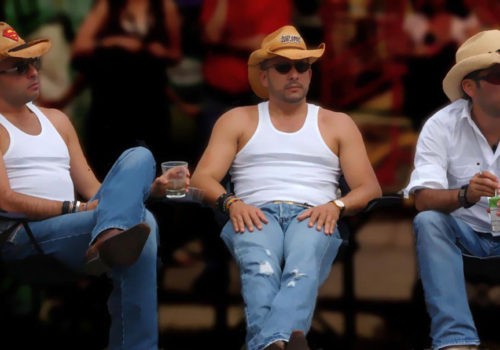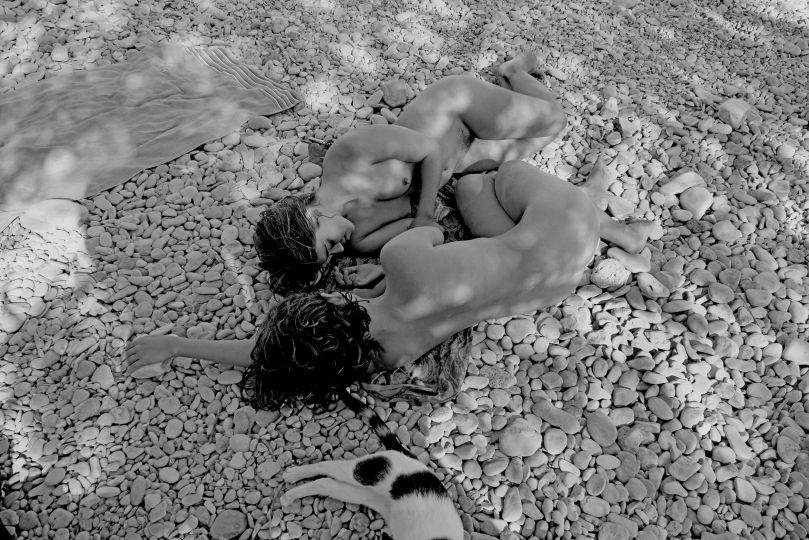The celebrations of Palmares, which are held the second week of January are considered “second parties” after the end of the year. As part of these celebrations is El Tope de Palmares, one equestrian activity that has come to mean an excuse for the expression of sexual and erotic behaviors prohibited during the Christian family celebration of Christmas just passed. Therefore, the behavior recalls the myth of the centaur. Considered savages, without laws or hospitality, slaves and animal passions metaphor for the conflict between instincts and civilized behavior in humankind. The centaurs were notoriously violent and enjoy pleasures like wine, women and hunting. Were considered the embodiment of feelings like anger and therefore representatives of barbarism and male lust. Keywords: Equestrian, Centaur, sex, passions, pleasures, male lust.
After photographing for several years El Tope de Palmares, I could capture the erotic and sexually charged feeling of that activity. People from many urban areas of San Jose and surrounding assists displayed before watching the parade of
horses. Both men and women circulating half- naked or sit at the edge of the road seen the beautiful horses pass with their round and sensual shapes, with an exhibitionist attitude that rivals the horses. It would be normal to see this exhibition of the body in coastal areas where heat requires light clothing, but Palmares is just over 1,000msnm and January is windy and very cool. So how do you explain this behavior?
Costa Rica as part of Post Modernism, of the consumer society, the sexual revolution, the breakdown of religious institutions and a globalizing acculturation is undergoing changes as the rest of the world. Mainly regarding the cultural stereotype rooted in Western Christian culture, where an intrinsically evil and sinful flesh, which plays an “anarchist king of revelry, emblem of overeating, drinking, sex and violence” role (Porter, 1996: 271). These behaviors are tolerated by the local society, political authorities and religious leaders because they mean a significant amount of money to the coffers of the host community. Traditionally horse parades provide a framework for the mighty men, mostly politicians and wealthy who pay the registration to participate, mounted on beautiful and expensive horses; over which they exercise control, and these subjugated with bits that hurt their faces causing great pain, running all kinds of tricks to satisfy the whims of their masters. These horses are a symbol of the mastered and dominated the subjected and
subjected, by force or seduced by advertising also paid by organizations controlled by them. Perpetuating the image of the inferiority of the body to be dominated and suppressed their irrational impulses, for the reason-soul, intelligence and logic of the Christian moral patriarchal prevail. This is where we see the body as a battlefield, on the one hand the power and the other’s identity, besides the contradictory discourse of the double standard. Anthony Giddens describes sexuality as a “social construct, which operates in fields of power, not merely a range of biological impulses or released or not released” (Giddens, 1995: 31) is a key terrain of political struggle and a means of emancipation “[Giddens, 1995: 165].
The manifestation of the archetype of the Centaur is the problematization of ourselves, discussing our sexuality, sexuality, at the end of the day, regulated, disciplined, organized, stimulated, involved and co-implicated: located in one word. Some of the photographs included in this small series can be seen as the contradiction of this postmodern sexual liberation which aims to see reflected their false consumerist dreams part of the media-advertising show, as the recovery of the body, the self, against Christian morality – patriarcal. Manuel Castells suggests that a “sexually liberated society” can be a simple “supermarket of personal fantasies, in which the desires of individuals are consumed by each other instead of created by them” [Castells, 1998: 265].
And, in the same way, Porter, citing M. Featherstone, argues that in today’s capitalism, social control efforts have shifted to the iron discipline exercised in the production world of work the “body as a consumer, overflowing of desires and needs, which will have to revive and stimulate “[Porter, 1996: 274]. Michel Foucault sums in a very concrete way: In the context of a multiplicity (postmodern) stories, made of ruptures and discontinuities of advances and retreats, pleats and folds, will have to accept the indefinite and indeterminate character of the fight against a power which, in our particular historical context, has taken the form of economic exploitation “(and perhaps ideological) of eroticism, from tanning products until porno movies “[Foucault, 1992b: 113]. It is the argument of this observer that activities like horse parades and carnivals and even civic and religious holidays are scenarios for an expression of a plastic body as advertising representations of normalized bodies, being one of its consequences the loss of privacy and therefore of intimacy. And from the standpoint of post-photography the body is reconstructed as a spectacle, a body to be photographed, rebuilt trans-subjectively by the “industry of persuasion” of social media. The theme of biopower incumbent in this spectacular beginning of XXI century to the expropriation, to the almost total commercial colonization of the body, expressed materially by the imprint of the trademark as a hallmark and essential principle of
classification. This informational embodiment, alienated and phagocytosed by a reduced- hegemonic “Empire” of a consumer behavioral and reactionary logic system corporeality, refers to a body-simulation exercise in an eternal compulsive self-contemplation. This will always return to dissatisfaction and frustration of eternal distance from a universal model of perfection and fullness, nonexistent. I think, today, we are witnessing a technocratic redefinition of the ancient Christian device of sexuality in both the power of the image represents a new secular version of that process outlined by Foucault as “correlation between disclosure of the self, dramatic or verbally and the renunciation of the self “[Foucault, 2000a: 94]. Now, it is about the disappearance of the sensible world of body- merchandise in favor of its images as the sensible par excellence, since “the world both present and absent at the same time which the spectacle makes visible is the world of the commodity that dominates experience ‘[Debord, 2001: 52]. We live, therefore, in a world where the conversion of our bodies in simulations relegates us to a real phantasmagorica- existence based on the –none distinction of hiper-real between true and false, the real and fiction where it appears to be what it is not, is stamped into which the face and body die on the operating table cosmetic surgery; in a world where the desperate search for the “Great Virtuality” takes us not only in the “liquidation of the Real and the referential, but also in the era of
extermination of the Other” [Baudrillard, 1996: 149]. Add to this the imposition of an ethics of cosmetic –cosmetic comes from the root kosmevw, to decorate, put in order- wherein said compulsive obsession with image and “ornament” the body corresponds to the complementary emergence of a social “order” leaning against a selfish consumerism strengthened by fear and rejection of the “other”. We live in a world where relationships of the subject himself and his own body, with others, with the world and with historical time, responds to values such as: the cult of body image; exaltation of the ideals of beauty, youth, wealth and fame; reducing the existence of a present devoid of any reference of past and future; the relentless pursuit of personal fulfillment; the glorification of desire; renouncing revolutionary political, social, religious goals, etc. regardless of social class or economic possibilities.
No part of this work is to propose what to do, since that would require a major community effort, however, for the recovery of our bodies and ourselves have bound to re-discover in history, re-imagining, re-interpreting, dialogic and creatively, our bodies. Just making history, you can do politics, politics we want, politics we need in our here and now problematized.
_________________________
This article is reserved for subscribed members only. If you are already a member, you can log in here below.
Subscribe for full access to The Eye of Photography archives!
That’s thousands of images and articles, documenting the history of the medium of photography and its evolution during the last decade, through a unique daily journal. Explore how photography, as an art and as a social phenomenon, continue to define our experience of the world. Two offers are available.
Subscribe either monthly for 8 euros (€) or annually for 79 euros (€) (2 months offered).
















